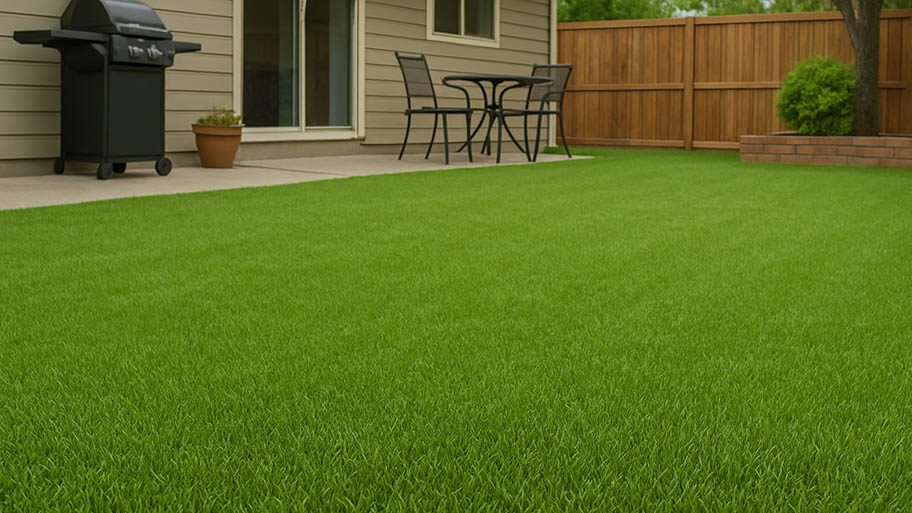
Removing an old lawn is often necessary to plant new grass or build a new outdoor structure. Find out what to budget for your lawn removal cost.
Compare and contrast two of the most popular cool-season grasses


Kentucky bluegrass is a cold-season grass, while tall fescue is a warm-season grass.
Kentucky bluegrass requires more maintenance than tall fescue.
Tall fescue is more resilient to foot traffic than Kentucky bluegrass.
Growing the greenest grass starts with choosing the right variety of seed, and if you live in a cooler climate zone, you’re likely choosing between Kentucky bluegrass vs. tall fescue. Still, while they thrive in similar climates, each has its own pros and cons, and ideal conditions for growth. Here’s a look at the differences between tall fescue vs. Kentucky bluegrass, and which will work best for your lawn.

At first glance, both grass species are similar, including being cool-season turf species and creating dark, rich lawn colors. There are even a variety of successful cross-species blends between the two.
Kentucky bluegrass tends to be a softer, more lush grass that feels and looks great but sacrifices some vulnerability to the elements and lawn diseases. On the other hand, tall fescue is a taller, hardier grass that grows more easily, stands up to more foot traffic, and needs less maintenance.
Great experience from start to finish. They responded to my inquiry quickly and came out to give me a quote the same day. My yard was overgrown with weeds and needed lots of trimming. The guys came out and pulled all of the weeds by hand to get them out by the roots and trimmed up nicely. They were able to come up with a treatment plan within my budget to get my lawn and yard looking great again. Very professional, efficient and knowledgeable.

Kentucky bluegrass is a classic type of grass that is brilliantly hued and undeniably soft, though it can be high maintenance. These are the main pros and cons of this grass.
| Kentucky Bluegrass Pros | Kentucky Bluegrass Cons |
|---|---|
| Beautiful emerald color | Long germination time |
| Soft underfoot | Higher maintenance than many grasses |
| Excellent in colder weather | Easily damaged with high traffic |
| Easy to repair after damage | Vulnerable to high heat |
| Friendly to wildlife and home lawns | Needs lots of water |
| Great for picnics and gentle recreation |
Kentucky bluegrass is soft and vibrant, with a signature bluish-green tint that gives it its name. Highly tolerant to cold, it’s a prime choice for areas that experience frigid winters. On top of that, it’s capable of self-spreading and repairing itself from trampling feet, digging paws, and burrowing pests.
While it can self-spread to patch up bare and brown spots once it’s fully established, Kentucky bluegrass takes a while to grow. It’s high-maintenance, requiring above-average amounts of water and fertilizer treatments. Also, while it’s one of the softest types of grass out there, it’s more susceptible to being trampled, so it’s not ideal for high-traffic lawns.
Home lawns that get heavy sunlight exposure
Grass that needs to accommodate wildlife, pets, and people
Homeowners who want lush, dark lawns
Homeowners that don’t mind regular spring maintenance
Homes in cooler, moderate climates

Tall fescue grass is a bit rough under bare feet, but it’s fairly low-maintenance and extremely hardy. Here are the main pros and cons of tall fescue.
| Tall Fescue Pros | Tall Fescue Cons |
|---|---|
| High heat tolerance | Requires a large amount of shade |
| Highly resilience against traffic and droughts | Struggles in harsh cold |
| Doesn’t need much sunlight | Doesn’t repair itself easily |
| Easy maintenance | Higher, rangy growth doesn’t look good on every lawn |
| Vibrant green color |
Tall fescue has a deep root system, making it extremely resilient against droughts and damage. It has minimal fertilization needs and average water intake, making it relatively easy to maintain. Tall fescue also has high heat tolerance and moderate shade tolerance, making it a great choice for lawns in hotter climates that might not receive full sun.
Tall fescue isn’t as tolerant to harsh cold, so it’s best for southern cool-season and transition zones. It also can’t self-spread and repair itself from damage, so you will need to reseed or budget for the cost of resodding to address any bare or brown patches.
Lawns that get heavy foot traffic
Lawns that need to grow in quickly
Yards with plenty of shade
Homes in warmer "transition" climates
Homeowners willing to let their grass grow longer than normal
Areas that can struggle with drought or grass diseases
Here’s a comprehensive comparison between tall fescue vs. bluegrass.
Tall fescue is dark, true emerald green, while Kentucky bluegrass is a brighter green with a bluish-green tint. Tall fescue’s blades are thick and coarse, whereas Kentucky bluegrass has a soft, lush texture that’s especially captivating on a breezy afternoon.
Keep in mind, there are a number of cross-varieties between Kentucky Bluegrass and Tall Fescue, such as Tuff Turf Tall Fescue, which combines the appearance of both species to make it easier to get the look you want.
Kentucky bluegrass has a fine, soft texture that is much more foot-friendly than tall fescue’s coarse blades. Keep in mind that, due to its softness, Kentucky bluegrass can’t stand up to heavy foot traffic, so try not to go too far beyond your morning barefoot walks to water your garden.
Tall fescue is thin and coarse, making its blades more resilient to foot traffic than soft, plump Kentucky bluegrass. However, tall fescue can’t self-spread and repair itself the way Kentucky bluegrass can, so you will need to add more sod or reseed your lawn to fix areas that get heavily trampled.
Both tall fescue and Kentucky bluegrass are cool-season grasses that can withstand colder weather, but Kentucky bluegrass is much more tolerant of cold. This trait makes it ideal for northern U.S. regions that experience particularly frigid winters.
While Kentucky bluegrass stands up to the North’s coldest winters, extreme heat and sunshine can scorch or kill its leaves. Tall fescue is more tolerant of hot weather, making it best suited for transitional climate zones and cool-season regions with milder winters.
Fescue requires at least 1 inch of water per week, which is in line with what most types of grass need. Kentucky bluegrass, on the other hand, needs an above-average amount of 1¼ to 1½ inches per week. During summer days when there’s been a dry spell from rain, both grasses may need up to 2½ inches of water per week.
Kentucky bluegrass needs well-draining soil with a pH between 5.8 to 7.0, while tall fescue does best in rich, clay-based soils with a pH of 5.5 to 7.5. Kentucky bluegrass needs more nitrogen-based fertilizer treatments to maintain its ideal soil pH and it’s also more sensitive to soil compaction. Before you choose your grass, it’s always a good idea to have your soil tested by a local soil testing service to learn which type of grass is naturally suited for your soil type.
Tall fescue germinates within 7 to 21 days. Kentucky bluegrass takes longer to germinate, averaging about 10 to 21 days. Kentucky bluegrass also generally takes longer to grow and become established.
Kentucky bluegrass is a sun-loving grass that needs at least 8 hours of direct sunlight daily in order to thrive. Tall fescue is much more tolerant of shade—it actually prefers partial shade over full sun and only needs about 4 hours of sunlight per day.
If you have Kentucky bluegrass, you’ll need to aerate your lawn every two to three years to ensure proper soil drainage and keep your grass thriving. Tall fescue isn’t as fussy, although it benefits from an annual overseeding to keep the blades dense and vibrant.
With its fine leaves and shallow root system, Kentucky bluegrass is more vulnerable to being overtaken by weeds. Tall fescue has deeper roots and can compete against any weeds that try to take over.
Kentucky bluegrass and tall fescue can both play host to common lawn pests such as ants, grubs, and webworms. During hot summer days, Kentucky bluegrass becomes more susceptible to disease and weed takeovers, while tall fescue tends to be more vulnerable to fungi like brown patch disease. However, Kentucky bluegrass has a shallower root system and can easily be damaged by digging moles, voles, and grub-hungry birds.
Kentucky bluegrass thrives at cutting heights around 2 to 3 inches during its highest growing months. If you let it grow too high, it may encourage mold problems, so it’s important to cut it regularly. Tall fescue, as the name suggests, prefers a higher height at around 4 inches which you can lower during the wetter growth seasons.
We’re giving Kentucky bluegrass a slight edge because the lower height tends to look better for most home lawns while four-inch turf can look messy over time. However, if you want to worry a less about mowing, tall fescue may have an advantage.
Both grass species can benefit from fertilizer. However, Kentucky bluegrass is a bit more "needy," thriving with regular fertilizer applications (usually with a 32-0-5 mixture) every few weeks during its growing season. Tall fescue with its deeper roots and durability doesn’t need such frequent fertilizing, but could use a pre-emergent fertilizer and another application heading into the hot summer days.
From average costs to expert advice, get all the answers you need to get your job done.

Removing an old lawn is often necessary to plant new grass or build a new outdoor structure. Find out what to budget for your lawn removal cost.

Your total lawn care cost depends on several factors, including the type of service and lawn size. Our guide will cover what you can expect to pay for lawn care.

Artificial grass is a low-maintenance alternative to traditional turf. Learn how much artificial grass installation costs and what affects your price.

Bark and mulch are materials that can beautify your yard and boost its health. Compare bark vs. mulch to decide which one is right for your lawn.

If you’re dreaming of growing a thick, healthy lawn, one of your key questions will be: How much grass seed do I need? Learn how to calculate it in this guide.

Straw is a popular mulching choice for newly planted grass. Should you put it down when planting grass? Find out the answer in this guide.